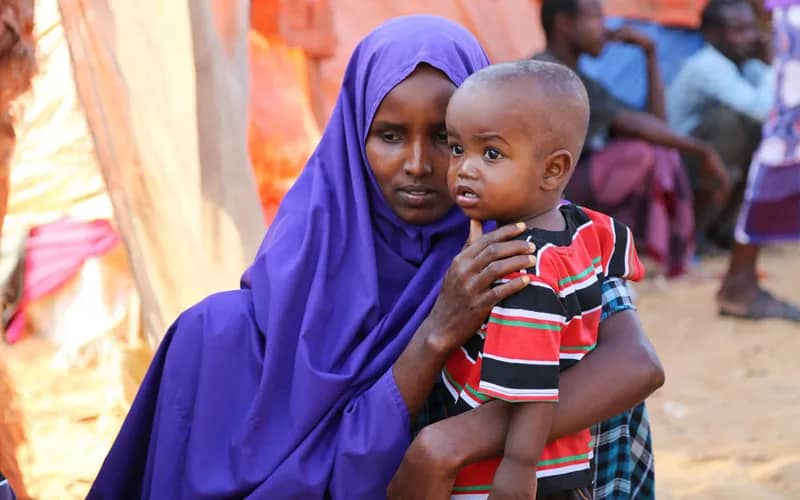YAOUNDÉ, Cameroon – In the face of adversity, Mary’s Meals has been a constant source of support for the children of Tigray, the northernmost region of Ethiopia.
Mary’s Meals is a Catholic-inspired charity which sets up school feeding programs in some of the world’s poorest communities, where hunger and poverty prevent children from gaining an education.
Since 2017, acting with the Daughters of Charity religious order, the group has been nourishing the future of Tigray by providing school meals. Their commitment didn’t waver even as the COVID-19 pandemic forced schools to shut down; instead, they sent take-home rations to ensure no child was left hungry.
The outbreak of armed conflict in Tigray from November 2020 only intensified their resolve. Mary’s Meals and its partner remained on the ground, turning to emergency support, delivering hot meals and essential aid to over 30,000 displaced individuals in Mekelle, the region’s capital.
As parts of Tigray witnessed the reopening of schools, Mary’s Meals was there, resuming its in-school feeding program. Recognizing the dire need, they expanded their reach, almost doubling their feeding capacity from 24,000 to 45,000 children. This act of compassion provided a glimmer of hope in a region yet to recover from a devastating two-year civil war and now facing a severe drought.
“Local media recently reported that almost 400 people, including 25 children, were reported to have succumbed to death by starvation in a single month in Tigray,” Helena Finnegan, Communications Manager, Mary’s Meals USA told Crux.
With agriculture crippled, farmers stand helpless, with no produce to sell, no food to sustain their families, and no hope for future harvests.
The situation is dire, with millions in urgent need of aid to survive, countless children deprived of an education, and approximately one million residents confined to IDP camps, longing for home.
Mary’s Meals’ response to this crisis is not just about providing food; it’s about nurturing resilience, restoring dignity, and fostering hope in the darkest of times, according to Finnegan.
Following are excerpts of that interview….
Crux: You have talked about an upsurge in hunger in the Tigray region of Ethiopia, two years after the ceasefire. How dire is the situation?
Finnegan: Since 2017, Mary’s Meals and its trusted partner have been providing meals to children in schools in Tigray.
During 2020, when schools closed because of the pandemic, Mary’s Meals provided take-home rations to the families of the school children. Just as schools prepared to open later that year, armed conflict broke out across Tigray from November 2020 to November 2022.
Working with its in-country partner that stayed throughout the conflict, Mary’s Meals pivoted to emergency support that included hot meals and other essential assistance for more than 30,000 internally displaced people in Mekelle, the region’s capital.
As schools re-opened in parts of Tigray last year, Mary’s Meals resumed in-school feeding, and responding to the acute need in the region, it nearly doubled its feeding capacity from 24,000 children to 45,000 children.
Tigray has not had the chance to recover from the deadly two-year civil war that raged until November 2022, and now the region is gripped by a drought that has left millions of people facing ‘emergency’ levels of hunger and in desperate need of food aid. Local media recently reported that almost 400 people, including 25 children, were reported to have succumbed to death by starvation in a single month in Tigray.
Fields that were already ravaged during the war lie empty, barren, and void of any life because of failed rains; thousands of cattle, a vital source of food and income, have died. Agriculture is one of the main occupations in the region, and now farmers have no supplies to sell, no food to eat, or even any hope of growing crops.
Official statistics estimate that millions of people are in need of vital aid to keep their families alive, alarmingly high numbers of children are out of school, and around one million people are still housed in internally displaced people (IDP) camps, unable to return home.
Famine has a very specific classification, and although the criteria haven’t officially been met to declare famine in Tigray, there are already reports of people dying from starvation and clear signs that the situation will rapidly deteriorate further if there is no immediate intervention.
Mary’s Meals founder and CEO, Magnus MacFarlane-Barrow, who recently returned from a fact-finding trip to Tigray, said, “It’s hard to exaggerate just how serious the situation is in Tigray. People are already dying of hunger, and everything we’re hearing on the ground points to a well-founded fear of much worse to come if the world doesn’t respond. We’ve heard accounts of children who no longer feel the pain from hunger pangs, not because they have eaten, but because they don’t have the energy to feel pain anymore.”
What would you say is responsible for hunger?
From 2020 to 2022, the region endured two years of deadly civil war that displaced millions, destroyed essential infrastructure and health services, and is estimated to have claimed the lives of upwards of 600,000 people.
Interruptions to aid supplies in 2023, compounded by several failed rainy seasons in recent years resulting in severe drought, have left lives and livelihoods in ruins and accelerated the region’s humanitarian crisis. Currently, the Integrated Food Security Phase Classification (IPC) hunger projections suggest that the majority of Tigray is experiencing IPC Phase 4 emergency levels of hunger, with predictions that “some households will likely be in Phase 5 catastrophe or famine by July.”
A lethal confluence of factors has contributed to the current dire situation – where both adults and children are already reportedly dying of hunger – and the scale of hunger is expected to worsen.
What impact has it had especially on children?
In Tigray’s largest hospital, Dr. Abraha Gebreegziabher, a local pediatrician, explained to Mary’s Meals that more and more children are dying from malnutrition in his hospital. “We are seeing three times as many cases of malnutrition as normal, and the mortality rate is five times higher. The number of children dying from malnutrition was quite stable for the last 13 years, but since the war, it’s doubled. Previous deaths were generally linked to other health conditions, but now malnutrition is a singular cause on its own,” he said.
Their lives and futures are also at stake because millions are out of school, are not currently enrolled, and only 40 percent of children are able to continue their education. The situation is made worse by serious staff shortages and damage to school buildings sustained during the conflict; approximately 15,000 teachers are still unaccounted for, and as much as 95 percent of classrooms in the Central Zone of Tigray – an area where much of Mary’s Meals school feeding takes place – are damaged because of the war.
Children have missed years of education as a result of long-term school closures – because of COVID, followed by a two-year armed conflict that either destroyed schools or turned them into shelters for displaced people – and according to our on-the-ground partner, many are now dropping out or struggling to learn because of daily hunger and the results of trauma from the conflict. Around a quarter-of-a-million children are said to be at risk of dropping out of school because of the imminent threat of starvation caused by the ongoing drought crisis.
Malnutrition and hunger are immediate and urgent concerns. According to our local partner, across the Tigray region, almost one-fifth of children under the age of five suffered the two most severe levels of acute malnutrition. Around one-third of children were underweight in Tigray, and of those children, 7.6 percent were severely underweight. Since the end of the war, more than 1,940 hunger-suspected deaths have been identified in Tigray.
What do you think would happen without urgent intervention and how much aid do you think would begin to address the problem?
Currently, FEWS NET predicts ‘crisis’ and ‘emergency’ levels of hunger across most of Tigray.
Given the ongoing displacement of about one million people across the region, more than two years after the conflict ended, and the ongoing drought, which has dried up what little food, livestock, and resources were left after the war, the consequences are dire, and the need for feeding support is as critical as ever.
School meals are a lifeline for children in Tigray, as they not only keep them in school by giving them a reason to attend but also help their families keep them alive. Professor Afewerki Mulugetu, Professor of Public Health and Lecturer at Mekelle University College of Health Sciences, who works at the Ayder Specialized Hospital in Mekelle, spoke to Mary’s Meals personnel recently regarding the problem of malnutrition and relapse.
“One of the timely and right interventions, I would say, is school-feeding programs,” he said.
Local Tigrayan officials have indicated that an estimated 25 percent of schools are on the brink of closure due to a lack of attendance because children are displaced, missing, or unable to attend because of hunger. Although Mary’s Meals has adapted its program over the years to provide emergency aid when it was most urgent, it is firmly focused on the provision of school meals because it’s what is most needed in communities to stop children from starving while also safeguarding their future.
“Everywhere we go, people are asking us to expand our program to schools so that we can keep the children fed and in school because their education will determine the future. One of the defining things about this situation is that we can – and are ready to – roll out the Mary’s Meals program to many more schools if we can mobilize more support and raise the necessary funds,” said MacFarlane-Barrow.
Mary’s Meals has obviously been involved in providing school meals for children in Tigray. How challenging is this mission?
Mary’s Meals is adept at serving meals to children in some of the world’s most challenging environments, including Haiti, Syria and Yemen. As in many of the countries where our meals are served, Mary’s Meals works with a partner organization in Tigray, which delivers our school feeding program? They are our greatest strength and have a remarkable ability to adapt and pivot as the need dictates, enabling us to reach more than 45,000 children with school meals and many more if funds allow.
In Tigray, it can be difficult to predict school enrollment and attendance numbers at the schools where our meals are served because of the scale of displacement and movement combined with the widespread need for families to try and find food. Rebuilding school and kitchen facilities is also being undertaken, as much of the school feeding infrastructure that was in place before the war has been looted or damaged. The ongoing drought means that there is very little local produce available to prepare the school meals, so Mary’s Meals must source supplies from elsewhere in Ethiopia, and with that comes additional logistical challenges.
Furthermore, journalists are struggling to gain access to the region, meaning the unfolding hunger crisis in Tigray has been largely underreported, so people are unaware of this unfolding catastrophe to be able to take action. Many more people would have died in that terrible famine in the 1980s if it hadn’t been for the enormous global media focus and resulting humanitarian effort. As a charity with a commitment to communities in the region, we have an enormous responsibility to share the stories of the people we have met in Tigray and to raise awareness of the crisis that is happening right now.
“It’s hard not to make comparisons between how the world was so moved to act nearly 40 years ago when Ethiopia was gripped by the infamous famine of the 1980s and the situation today that is virtually being ignored. We need to make sure that the terrible outcome Tigray is heading for doesn’t happen, but it will if we don’t act now,” MacFarlane-Barrow stated.
















